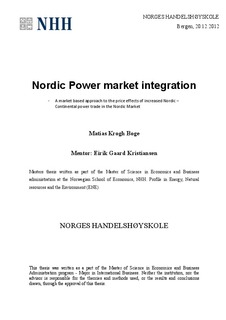Nordic Power market integration : a market based approach to the price effects of increased Nordic continental power trade in the Nordic market
Master thesis
Permanent lenke
http://hdl.handle.net/11250/169531Utgivelsesdato
2012Metadata
Vis full innførselSamlinger
- Master Thesis [4372]
Sammendrag
Based on historical market data for 2011 this thesis models estimated effects that increased
Nordic-Continental power trade potential would have had on trade and on Nordic prices
during this year. The model used differs from most other models used to estimate trade
effects as it focuses on realized market data contrasted to the more commonly used
fundamental bottom up model of the power market.
The approach used in this work suggests that one extra interconnector combined with
internal grid improvements lowers Nordic prices in a strained hydro situation with 4-5€ and
raises the price level slightly more in a surplus situation. It also suggests that the Nordic
system will import a significant amount of hourly price volatility even at this modest
increase in trade capacity. Even though the hourly price volatility is probably overestimated,
the estimate is likely to be more robust on the downward volatility. In other words the results
suggest we are likely to import the very low prices experienced during nightly hours on the
continent to a greater extent than the hourly peaks during midday. Further, the results
suggest that internal grid improvements have a similar effect on price level as the actual
added interconnector.
Price level effects are in line with other research and simulations from fundamental power
market models, the hourly volatility effect is however suggested to be stronger in this market
based model than what other research has suggested. Unless demand becomes more
responsive to hourly price signals I believe that the estimations on the downward volatility to
be pretty robust and defendable even when the effects of the simplifications that have been
made are taken into account. The estimated effects varied considerably over the year.
